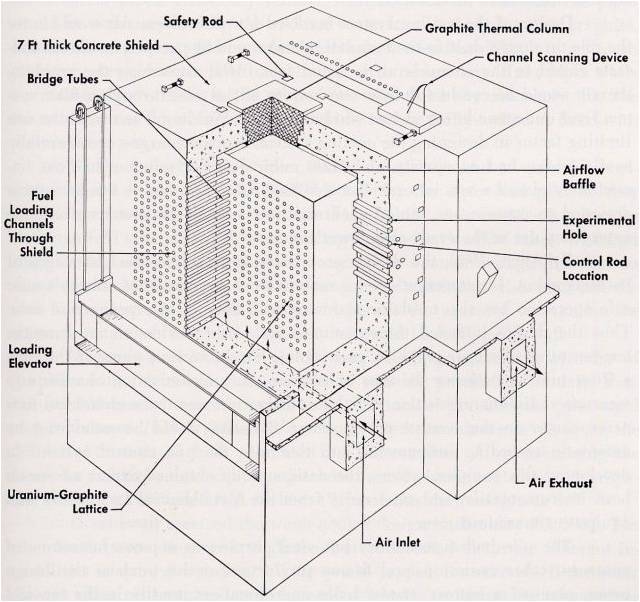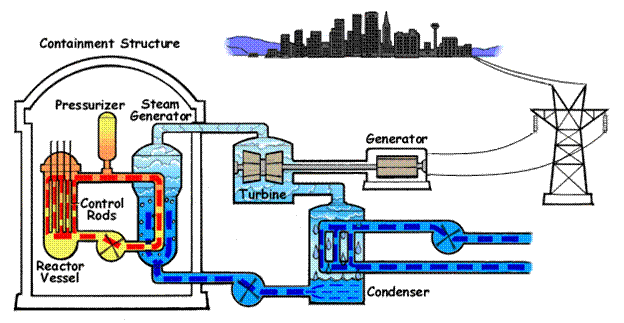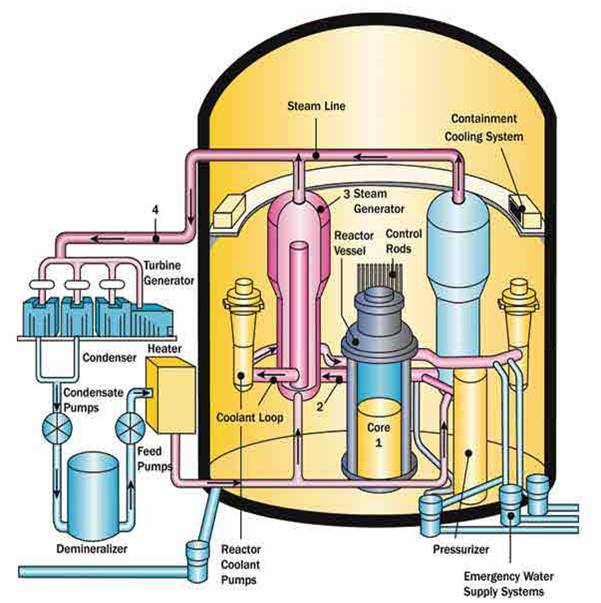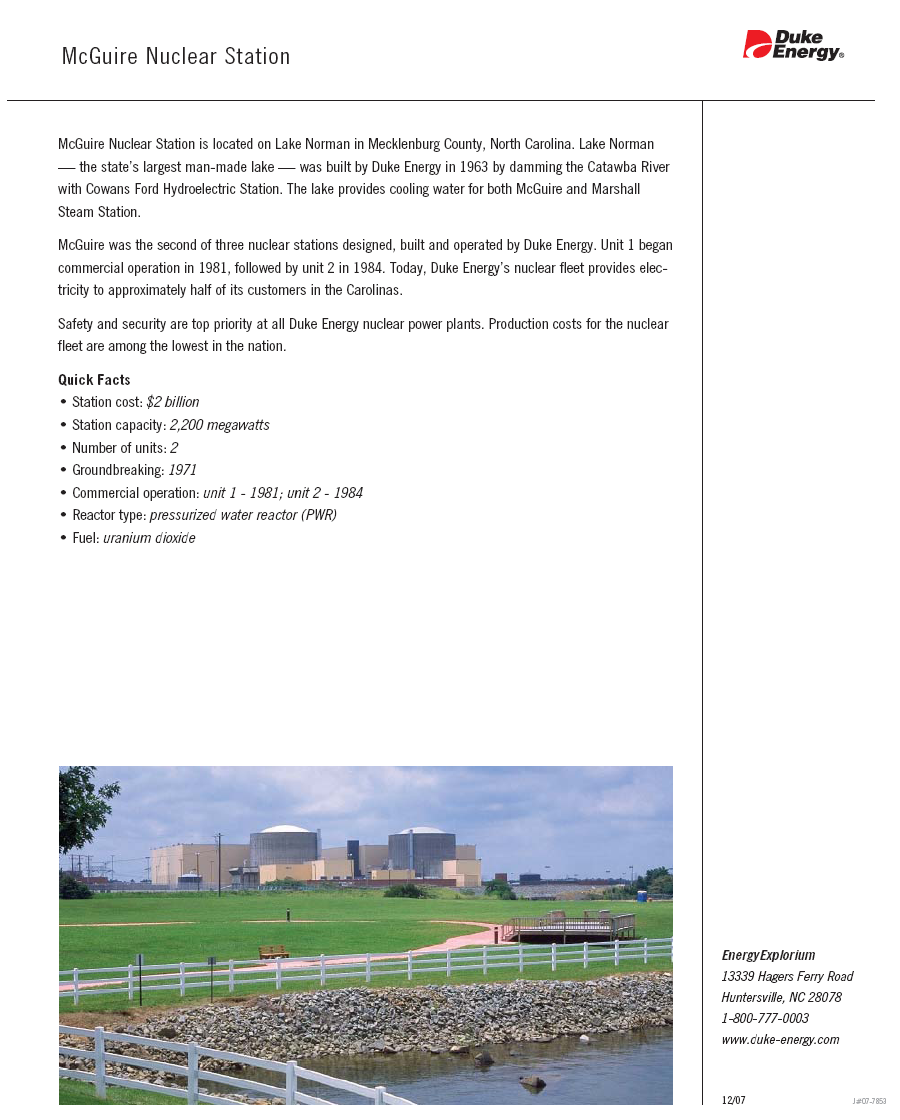Nuclear Energy
Basic Nuclear Science
Nuclear power plants function in a way that closely resembles coal and natural gas power plants. Each of these plant types function on the same basic principles of energy conversion. Potential energy is converted to heat energy, then to kinetic energy, then to mechanical energy, which produces electricity. In a coal power plant and a nuclear power plant, the only major difference comes from the way potential energy is converted into heat energy.
Energy cannot be created nor destroyed, but it can be converted from one form of energy to another. When a wooden log is used to start a fire, the potential energy of the log is being converted to heat energy. In the same way, a lump of coal has potential energy, and when combusted its potential energy is converted to heat energy. In a coal power plant, this heat energy converts water from liquid form to steam, which ultimately produces electricity.
In a nuclear power plant, we see the same principles at work. Atoms carry with them an amount of potential energy which can be converted to heat energy by means of a nuclear reaction. This reaction is accomplished in two ways, by nuclear fission and nuclear fusion. Nuclear fission involves breaking down an atom, usually a heavy metal such as Uranium or Plutonium, into smaller atoms and then breaking up the nucleus of the smaller atoms and releasing large amounts of energy in the process. Nuclear fusion involves the combining of two lighter molecules, forming a larger nucleus and releasing energy in the process.
Nuclear Fission
Nuclear fission is the splitting of heavy metal atoms, usually uranium or plutonium, into separate atoms, a process which releases large stores of energy from the original molecules. The following diagram shows a uranium molecule being bombarded with a neutron to momentarily become U-236, then splitting to Krypton and Barium molecules, releasing energy.
 Source: wikipedia)
Source: wikipedia)
Typical fission events release about two hundred million eV (200 MeV) of energy for each fission event. By contrast, most chemical oxidation reactions (such as burning coal or TNT) release at most a few eV per event, so nuclear fuel contains at least ten million times more usable energy per unit mass than does chemical fuel. The energy of nuclear fission is released as kinetic energy of the fission products and fragments, and as electromagnetic radiation in the form of gamma rays; in a nuclear reactor, the energy is converted to heat as the particles and gamma rays collide with the atoms that make up the reactor and its working fluid, usually water or occasionally heavy water.
Nuclear Fusion
Nuclear fusion as a means of power production has yet to be commercially realized. Research and development into the process of harnessing a fusion reaction for energy production is ongoing. Please refer to the following website for more information. ( source)
Just as in the coal power plant, the energy released from nuclear fission or nuclear fusion is used to heat water and convert it to steam, which can move a turbine and create electricity. This is a very basic explanation, but should suffice in the discussion of nuclear power.
In today’s reactors, most of the nuclear material being used is uranium. A distinction needs to be made between the uranium used in nuclear weapons and the uranium used in nuclear power. Uranium is unable to be used as a source of nuclear energy in its most natural state, which is U-238. U-235, which is a natural isotope (an atom with the same number of protons in the nucleus, but a different number of neutrons) of uranium, has an abundance of 0.71% in nature. For uranium to be used in a weapon, the percentage of U-235 must be around 90%. This is achieved by ‘enriching’ the uranium through processes which were developed in the Manhattan Project during World War II. One of these processes, the most common, is called gaseous diffusion, which is utilized at the Paducah Gaseous Diffusion Plant.
In nuclear power, as opposed to nuclear weapons, the percentage of U-235 in the fuel needs to be much less, around 5% or so. This reduction in enrichment makes the fuel and thus the nuclear power reactor much more stable. While a nuclear bomb and a nuclear power plant work on the same principles, the nuclear power plants fuel is much less reactive than a nuclear bomb core, and because of this the fuel in a nuclear power plant is not explosive.
Nuclear Energy Trends
Nuclear power is a major player in the global energy portfolio. As of 2009, 13-14% of the world’s energy is obtained through nuclear power. In the United States, the amount of energy from nuclear power is higher at 19%, as of 2005.
While historically nuclear power has been met with strong opposition and fears in the United States, a 2009 Gallup poll found that support for nuclear power has reached an all time high. The poll shows that 59% of Americans favor nuclear power as an addition to the means of producing electricity in the US, with 27% of those responders strongly favoring nuclear power. Even with this public support of nuclear power, another Gallup poll taken in 2005 showed that, while at the time favorable opinion of nuclear power was at 54%, the percentage of Americans who strongly oppose building a nuclear plant near their area was 63%. (source)
In 1994, the United States signed a $12 billion deal to buy 500 tons of weapons-grade highly enriched uranium (90% enrichment) to dilute and use in commercial nuclear reactors for power production. In 2005, the program reached its halfway point, boasting an elimination of 10,000 nuclear warheads.
Nuclear waste is a complex issue when dealing with nuclear power. Since nuclear waste is radioactive long after it is used as a fuel, the issue of what to do with the spent fuel is multi-faceted and not easily solved. The current process for dealing with nuclear waste is as follows: First, the separated waste or used fuel is in a stable and insoluble form. Second, it is (or will be) encapsulated in heavy stainless steel casks or in canisters which are corrosion-resistant (e.g. stainless steel and copper). Third, it will be geologically isolated. (From Ian Hore-Lacy Nuclear Energy in the 21st Century)
Nuclear waste can also be recycled, since even spent fuel can be recycled as fresh fuel elements, saving some 30% of the natural uranium otherwise required. A 1000 MWe light water reactor produces about 27 tons of used fuel per year. So far, more than 90,000 tons of used fuel from commercial power reactors has been reprocessed, and annual capacity is now approximately 5000 tons per year. (From Ian Hore-Lacy Nuclear Energy in the 21st Century)
Nuclear Reactor Components
While a nuclear reactor is a very complex system, it is possible to classify the components into four categories to gain an understanding of the makeup of the system.
- Fuel: Usually pellets of uranium oxide (UO2) arranged in tubes to form rods.
- Coolant: Liquid or gas circulating through the core so as to transfer heat from it.
- Modulator: Material in the core which slows down the neutrons being released from fission so that they can cause more fission.
- Control Rods: Neutron absorbing material such as cadmium that is inserted or withdrawn from the core to control the rate of reaction.


Reactor Types
Common practice is to classify reactors based on the type of coolant and modulator used. Some examples of nuclear reactor classification are as follows:
- Light Water Modulator Reactors
- Pressurized Water Reactors (PLWR)
- US, France, Japan, Russia, China
- Boiling Water Reactors (BLWR)
- US, Japan, Sweden
- Pressurized Water Reactors (PLWR)
- Graphite Modulator Reactors
- Gas Cooled Reactors (GCGR)
- United Kingdom
- Light Water Cooled Reactors (LWCGR)
- Russia
- Gas Cooled Reactors (GCGR)
- Heavy Water Modulator Reactors
- Pressurized Water Reactors (PHWR)
- Canada
- Uses Natural Uranium
- Pressurized Water Reactors (PHWR)
The following table shows the number and types of nuclear power plants in commercial operation throughout the world.
| Reactor type | Main Countries | Number | GWe | Fuel | Coolant | Moderator |
| Pressurized Water Reactor (PWR) | US, France, Japan, Russia, China | 265 | 251.6 | Enriched UO2 | Water | Water |
| Boiling Water Reactor | US, Japan, Sweden | 94 | 86.4 | Enriched UO2 | Water | Water |
| Pressurized Heavy Water Reactor 'CANDU' (PHWR) | Canada | 44 | 24.3 | Natural UO2 | Heavy Water | Heavy Water |
| Gas-cooled Reactor (AGR & Magnox) | UK | 18 | 10.8 | Enriched UO2 | CO2 | Graphite |
| Light Water Graphite Reactor (RBMK) | Russia | 12 | 12.3 | Enriched UO2 | Water | Graphite |
| Fast Neutron Reactor (FBR) | Japan, France, Russia | 4 | 1.0 | PuO2 and UO2 | Liquid Sodium | None |
| Other | Russia | 4 | 0.05 | Enriched UO2 | Water | Graphite |
| TOTAL | 441 | 386.5 |
Typical Boiling Water Reactor
The Boiling Water Reactor is one of the two most common types of nuclear reactor found in the United States. The following diagrams show a simple schematic of how the boiling water reactor functions.


Typical Pressurized Water Reactor
The Pressurized Water Reactor is one of the two most common types of nuclear reactor found in the United States. The following diagrams show a simple schematic of how the pressurized water reactor functions.


Detailed Nuclear Plant Schematics
One possible future use of the PGDP site is a nuclear power plant. An example of one potential type of nuclear power plant is provided in a brochure provided by AREVA. Before such a facility could be built, several regulatory hurdles would first have to be overcome, including a current Kentucky statute that prohibits the construction of such a facility in the state of Kentucky.
For more general information, including an overview of the types of nuclear reactors, please see this Pocket Guide to Nuclear Reactors Pamphlet.
To find out more about Liquid Fluoride Thorium Reactors, a technology that is making a comeback in the nuclear energy industry, please see this document.
Catawba Nuclear Station

McGuire Nuclear Station
